
Continuous track or tracked treads are a system of vehicle propulsion used in tracked vehicles, running on a continuous band of treads or track plates driven by two or more wheels. The large surface area of the tracks distributes the weight of the vehicle better than steel or rubber tyres on an equivalent vehicle, enabling continuous tracked vehicles to traverse soft ground with less likelihood of becoming stuck due to sinking.

A snowmobile, also known as a snowmachine, motor sled, motor sledge, skimobile, or snow scooter, is a motorized vehicle designed for winter travel and recreation on snow. It is designed to be operated on snow and ice and does not require a road or trail, but most are driven on open terrain or trails. Snowmobiling is a sport that many people have taken on as a serious hobby. Common brand names in the United States include Arctic Cat, Polaris Inc. and Ski-Doo.

BRP Inc. is the holding company for Bombardier Recreational Products Inc., operating as BRP, a Canadian manufacturer of snowmobiles, all-terrain vehicles, side by sides, motorcycles, and personal watercraft. It was founded in 2003, when the Recreational Products Division of Bombardier Inc. was spun off and sold to a group of investors consisting of Bain Capital, the Bombardier-Beaudoin family and the Caisse de dépôt et placement du Québec. Bombardier Inc., was founded in 1942 as L'Auto-Neige Bombardier Limitée by Joseph-Armand Bombardier at Valcourt in the Eastern Townships, Quebec.

The DMC DeLorean is a rear-engine two-passenger sports car manufactured and marketed by John DeLorean's DeLorean Motor Company (DMC) for the American market from 1981 until 1983—ultimately the only car brought to market by the fledgling company. The DeLorean is sometimes referred to by its internal DMC pre-production designation, DMC-12. However, the DMC-12 name was never used in sales or marketing materials for the production model.
Thiokol was an American corporation concerned initially with rubber and related chemicals, and later with rocket and missile propulsion systems. Its name is a portmanteau of the Greek words for sulfur and glue, an allusion to the company's initial product, Thiokol polymer.
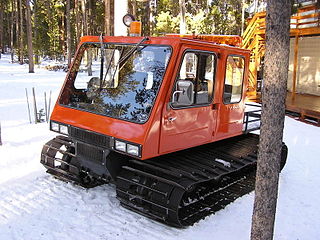
A snowcat is an enclosed-cab, truck-sized, fully tracked vehicle designed to move on snow. Major manufacturers are PistenBully (Germany), Prinoth (Italy) and Tucker.

The Ford Explorer Sport Trac is a pickup truck that was manufactured and marketed by Ford Motor Company for the North American market. The first mid-sized pickup truck produced by Ford, the Sport Trac was marketed from the 2001 to the 2010 model years. Sized between the Ranger and the F-150, the Sport Trac largely competed against crew-cab variants of the midsize Chevrolet Colorado/GMC Canyon, Dodge Dakota, Nissan Frontier, and Toyota Tacoma.

Operación 90 was the first Argentine ground expedition to the South Pole, conducted in 1965, by ten soldiers of the Argentine Army under then-Colonel Jorge Edgar Leal. It was performed to attempt to cement Argentina's claims to a portion of Antarctica, as well as for scientific reasons and to perfect polar exploration techniques. The operation was named after the target: 90 degree South latitude point. It has been described as the only documented military land maneuver on Antarctic territory since the 1959 Antarctic Treaty came into effect.

Snow grooming is the process of manipulating snow for recreational uses with a tractor, snowmobile, piste caterpillar, truck or snowcat towing specialized equipment. The process is used to maintain ski hills, cross-country ski trails and snowmobile trails by grooming the snow on them. A variation of the technique is used to construct snow runways in Antarctica.
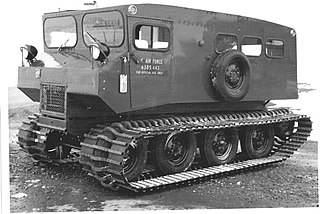
A snow coach is a specialized passenger transport vehicle designed to operate over snow or ice, similar to a large, multi-passenger snowcat equipped with bus-style seating. These vehicles may have multiple sets of massive, low-pressure tires, or they may have tracks. Snow coaches may seat ten or more passengers and are often used for sightseeing tours or over-snow transportation.

The Aktiv Grizzly was a dual-track snowmobile made by Aktiv Maskin Östersund AB in Sweden from 1979 to 1991. The Grizzly is still recognized one of the best dual track snowmobiles in the world. The snowmobile's tracks covered almost one square meter, making it well suited for use in deep snow. Similar dual-track snowmobiles include Bombardiers Ski-Doo Alpine, Ski-Doo Alpine 2 and Ockelbo 8000. Currently two dual-track snowmobile are in production, one in Russia under the name "Buran" and one in Italy, "Alpina Sherpa".
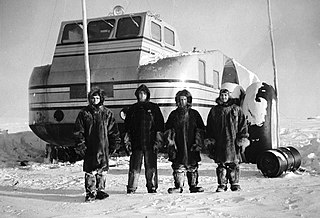
The Antarctic Snow Cruiser was a vehicle designed (1937–39) under the direction of Thomas Poulter, intended to facilitate transport in Antarctica during the United States Antarctic Service Expedition (1939–41). The Snow Cruiser was also known as "The Penguin," "Penguin 1" or "Turtle" in some published material.

The Snow Trac is a small personal Snowcat that is roughly the size of a modern compact car.
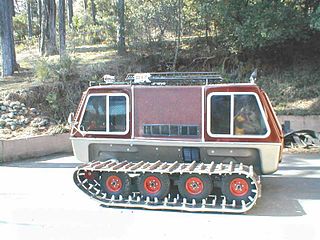
Kristi snowcats were 1950s/1960s tracked vehicles suitable for snow and other terrain and produced originally in Colorado and then later in Washington.

Logan Manufacturing Company was a US manufacturer of snowcats that ceased operation in 2000. LMC is both the tradename and an acronym.
Sno-Jet was a brand of snowmobile first produced in Quebec, Canada in 1965. They quickly proved popular and grew to be one of the highest-selling lines of snowmobiles until the early 1970s, helping usher the then-new sport of snowmobiling into Canada and the United States. The Glastron Boat Company acquired Sno-Jet in 1968. The company lost popularity after losing many races to Polaris colts. It was then sold to Kawasaki in 1976, who used the Sno-Jet name until 1980.
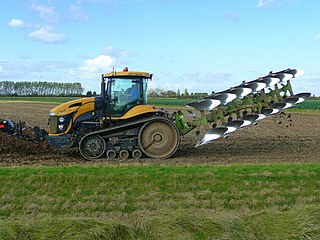
Challenger is an American brand of agricultural tractors. Created in 1986 by Caterpillar Inc., the brand was sold to AGCO in 2002. Since then, Challenger tractors have been manufactured at the company's Jackson, Minnesota facility.

Neumayer-Station III, also known as Neumayer III after geophysicist Georg von Neumayer, is a German Antarctic research station of the Alfred-Wegener-Institut. It is located on the approximately 200 metres (660 ft) thick Ekström Ice Shelf several kilometres south of Neumayer-Station II. The station's assembly kit was transported to its current position early in November 2007. It is moving with the shelf ice at about 157 meters (515 ft) per year towards the open sea.

The Allis-Chalmers M7 snow tractor was designed for use by the U.S. Army Air Corps as a rescue vehicle in remote northern bases.

Camso, formerly known as Camoplast Solideal, is a Canadian company that is a manufacturer and service supplier of products for off-the-road vehicles. They serve the material handling, construction, agriculture and powersport industries. Camso manufactures and distributes pneumatic, airless and solid tires, tracks, driven and trailed conversion track systems and OEM undercarriages. The company was founded in 1982, and is based in Magog, Quebec, Canada. It also has branches and manufacturing plants in America, Asia and Europe. Camso Research Centers are in Magog, Ghent, Sri Lanka, Shanghai & Ho Chi Minh City and has a global workforce of more than 8000 employees.

























